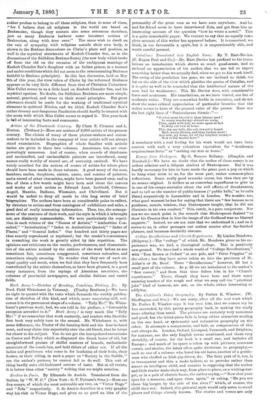The Children's Fairy Geography. By Forbes E. Winslow. (W. Skeffington
and Son.)—We are sorry, after all the real work which Mr. Forbes E. Winslow says it has cost him, that we cannot say he has succeeded, by this pretty geography book, in making the study more alluring than usual. The pictures are certainly very numerous and good, but the letter-press fails in being either attractive reading on the one hand, or systematic and exhaustive geography on the other. It attempts a compromise, and fails, as compromises of this sort always do. London, Oxford, Liverpool, Yarmouth, and Brighton, for instance, are the only English towns mentioned, and those very sketchily, of course, for the book is a small one, and includes all Europe ; and much of its space is taken up with pictures, nonsense verses, and stories, the latter often quite irrelevant to geography,— such as ono of a cabman who loved his old horse, another of a gentle- man who chaffed an Irish pig-driver, &c. The fairy part of it, too, is so transparent and thin a make-believe, as to provoke rather than amuse an intelligent child, and consists in supposing that the author and little reader make their way, from place to place, on a wishing-car- pet, or in a pair of electric boots, the author saying,—" Now shut your eyes for a moment, and open them again," or asking, "Do you see those big barges by the side of the river ?" which, of course, the child does not. Indeed, this pictorial style would only serve to recall places and things already known. The stories and versos are only
meant for very little children, and Mr. Winslow condemns his own book when he says, at page 31,—" You have no idea, my dear little one, of figures, but still I must make use of them," &c. And he does make use of them ; giving populations, imports and exports, &c., utterly useless to little children, and only appropriate to a book of systematic geography. If Mr. Winslow had simply chatted about such main features, scenery, climate, manufactures, history, biography, &c., of the different countries, as little, wee children could listen to with pleased attention, he would have attained his object, by interesting them in geography and exciting their desire for more knowledge of it ; but the pretence of a fairy-story will naturally disappoint them, and the dry details and lists will frighten them away. Fancy this for a little beginner !—without a copy of the picture to look at, observe :—" Look at that magnificent picture ! It is the famous Madonna di San Sisto, by Raphael ! Is it not beautiful ?"











































 Previous page
Previous page